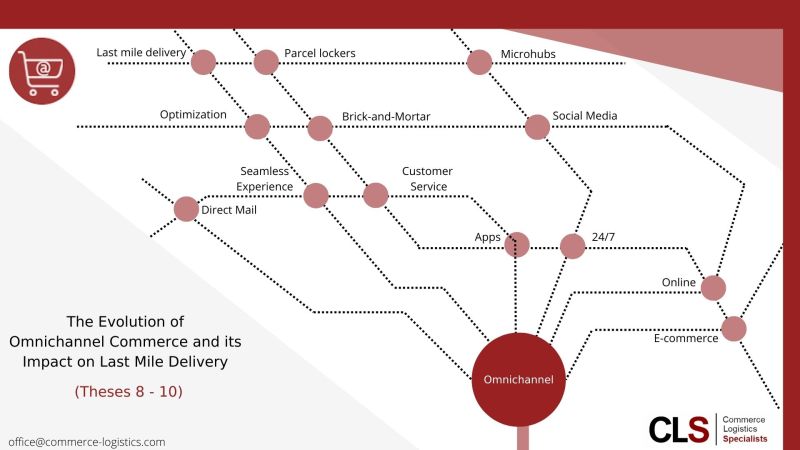Explained simply by CLS: The Evolution of Omnichannel Commerce and its Impact on Last Mile Delivery (These 8-10)

This article concludes our 3-part series featuring 10 theses on #ecommerce vs stationary #retail, the impact of the pandemic and digitalization, new regulations and the Ukraine crisis.
𝟴. 𝗧𝗿𝗮𝗱𝗶𝘁𝗶𝗼𝗻𝗮𝗹 𝘀𝘁𝗮𝘁𝗶𝗼𝗻𝗮𝗿𝘆 𝗿𝗲𝘁𝗮𝗶𝗹 𝗶𝘀 𝗱𝗼𝗼𝗺𝗲𝗱 𝘁𝗼 𝗱𝗲𝗰𝗹𝗶𝗻𝗲 – 𝗰𝘂𝗿𝗿𝗲𝗻𝘁 𝗱𝗶𝘀𝗿𝘂𝗽𝘁𝗶𝗼𝗻𝘀 𝗮𝗿𝗲 𝗮𝗰𝗰𝗲𝗹𝗲𝗿𝗮𝘁𝗶𝗻𝗴 𝘁𝗵𝗶𝘀 𝗱𝗲𝘃𝗲𝗹𝗼𝗽𝗺𝗲𝗻𝘁.
We are convinced that some #players in the brick-and-mortar retail #sector will succeed in becoming true #omnichannel providers, provided they acquire the necessary digital #competence and upgrade their ecommerce #servicequality. However, the #success of this #businessmodel depends on #optimizing their own intra-logistics, supplementing the stores with logistics functionalities (micro-hubs) so that existing last-mile logistics service #providers can be connected, #digitally managed by the retailer.
This will not help brick-and-mortar retailers, who see ecommerce only as an „additional mainstay“ and who continue to rely on #stores as their most important #saleschannel. As #consumers have less and less #disposableincome, we expect the current #crisis to further intensify #price #competition, also enabled by further efficiency gains thanks to ever-evolving #digitization. Sales via stores will not be able to keep pace with this #development, even when there will be niches for local / high-priced #offerings.
𝟵. 𝗡𝗲𝘄 𝗮𝗻𝗱 𝗶𝗻𝘁𝗲𝗴𝗿𝗮𝘁𝗲𝗱 𝗲𝗰𝗼𝗺𝗺𝗲𝗿𝗰𝗲 𝗲𝗰𝗼𝘀𝘆𝘀𝘁𝗲𝗺𝘀 𝗮𝗿𝗲 𝗲𝘃𝗼𝗹𝘃𝗶𝗻𝗴…
#COVID and the #Ukrainecrisis have permanently disrupted cross-border #supplychains. As a result, #traditional cross-border trade, which was based on low-cost and (relatively) fast air/sea/rail connections between e.g. Asia and the USA/EU, was hit hard and became less #competitive. #Suppliers with greater proximity to the #sales markets (without the need for the „middle leg“ and crossing #customs borders) and with highly efficient #warehouses/intra-logistics #managementsystems in the respective #customs areas gained a temporary #competitiveadvantage.
Supply chain #disruption results in new #business models based on #regional and #local intra-logistics, but managed by unified, interconnected digital processes (more on this in a separate post soon) #globally.
𝟭𝟬. … 𝗮𝗻𝗱 𝘄𝗶𝗹𝗹 𝗲𝗻𝗱𝗮𝗻𝗴𝗲𝗿 𝗹𝗮𝘀𝘁-𝗺𝗶𝗹𝗲 𝘀𝗲𝗿𝘃𝗶𝗰𝗲 𝗽𝗿𝗼𝘃𝗶𝗱𝗲𝗿𝘀
Standardized #global, modular #logistics chains, digitally managed are about to deployed. #Expanding and #controlling the entire / large parts of the #digital #valuechain – End-2-End – is #key to #efficiency and #cost leadership. Those not able comply, #risk to become interchangeable chain links managed by others.
Click here for the LinkedIn-Article.

Walter Trezek
Document Exchange Network GmbH

